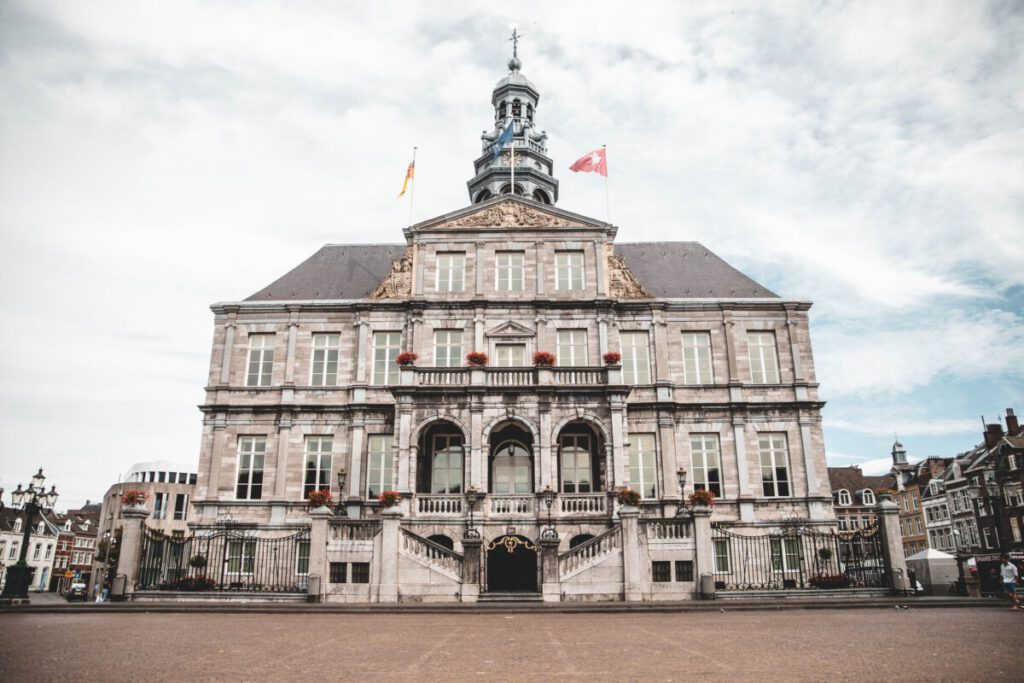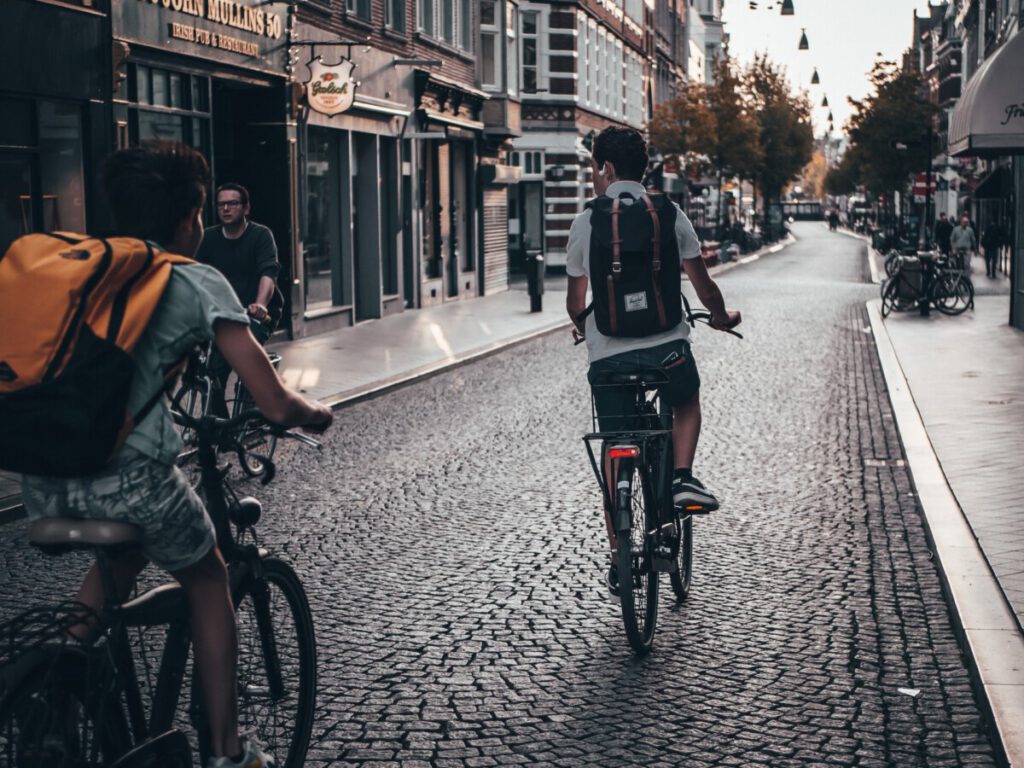So you’re considering studying in Maastricht. Great choice! You can look forward to making legendary student memories here, but first, there are many things to take note of when living in this Dutch city.
Studying in the Netherlands is a popular choice for many international students. I came to Maastricht from South Africa for my Bachelor’s degree. Flying across the world for my studies was a giant leap!
Whether you’re 20 hours or 20 minutes from this Dutch city, it’s worth understanding what you’ll be getting yourself into before you pack your bags and leave your home behind.
- 🇳🇱 The city of Maastricht
- 🏫 Universities in Maastricht
- 🌍 How international is it to study in Maastricht?
- 💰 Cost of living in Maastricht for students
- 🛌 How to find student housing in Maastricht
- 👩🎓 Student life: what it’s like to study in Maastricht
- ✅ Important things to know and do when moving to Maastricht
- 🫡 How to find a student job in Maastricht (when you don’t speak Dutch)
- 🚲 Getting around Maastricht
- 📚 Best study spots in Maastricht
- 🍺 Best places to eat and drink on a student budget in Maastricht
- ☀️ What’s the weather like in Maastricht?
- 💭 Why I chose Maastricht University
🇳🇱 The city of Maastricht
Maastricht will sweep you off your feet the moment you arrive, especially if you’re coming from outside of Europe. Medieval bridges, cobbled streets, and libraries built into cathedrals are all a part of the city’s unique charm.
Although it’s classed as a city in the Dutch context, to most internationals, Maastricht feels like a quiet student town, with very few high rises and green countryside a short cycle away from the centre. The unusual amount of hills in the area also makes Maastricht a great place for a gentle hike.

But arguably, the best thing about Maastricht is its location. As one of the southernmost cities in the Netherlands, you can cycle to Belgium in 20 minutes, take a 30-minute drive to Germany or be in Luxembourg within two hours.
If travelling around Europe is on your to-do-list, Maastricht is an excellent base-point as there are easily accessible airports in Maastricht, Eindhoven, Brussels, and Charleroi.
🏫 Universities in Maastricht
Before you get to study in Maastricht, you need to make your school choice! The largest and most internationally known university in Maastricht is, of course, Maastricht University (UM).
However, Zuyd University of Applied Sciences and the Maastricht School of Management also attract many foreigners. These institutions offer very different studies, but all have good reputations.
Maastricht University
Maastricht transformed entirely with Maastricht University’s opening in 1976, now ranked as the 13th best young university in the world. But even when age is out of the question, Maastricht University ranks high at 145th in the world for 2023.
The advantage of attending a new institution is that the learning approach is more innovative and interactive than traditional universities, which rely heavily on lectures. UM is known for the Problem Based Learning system (PBL), which emphasises practical case studies and class discussions over lecture-based learning (although lectures do still feature in the courses).
Degrees here range from Medicine to Art History but are often interdisciplinary — another great advantage. Combining politics and technology, economics and law, or philosophy and history (for example) is quite common.
Zuyd University of Applied Sciences
Zuyd Hogeschool is ideal for those of you looking to go into hands-on careers, like photography, healthcare, translation, and hospitality. For those of you who are more musically inclined, The Conservatorium may be your building of choice. Heavenly music pours from the windows at all hours of the day, making it a real musicophile’s haven.
At Zuyd, you can also study in fields of education, law, chemistry, and engineering, but the focus is on practical skills.
Maastricht School of Management
Dreaming of running your own hotel? Or turning your great business idea into a reality? Then the Maastricht School of Management (MSM) is for you. The degrees train you to work with people and manage organisations in any business context. Here, you’ll have a mixture of practical and theory-based assignments, as well as the opportunity to complete an internship in your desired field.
🌍 How international is it to study in Maastricht?
Maastricht University advertises itself as an international university, and they are not exaggerating. Around 22,000 students were enrolled in 2021, 56% of which were foreign students. An impressive 129 nationalities are represented in the university, but of course, the majority of which are EU citizens.
But even with these numbers, the experience you have will definitely depend on the faculty you go to and the clubs you join.
For example, at the Faculty of Arts and Social Sciences (FaSoS, where I went,) 77% of the students are international, with a good mixture of EU and non-EU citizens. You’ll take classes with Brazilians, Syrians, Italians, Australians, Koreans, Greeks, and Canadians — it’s incredible.
The School of Business and Economics (SBE) is technically also very international, but around Maastricht the faculty is known as “mini-Germany” because most of students there are German.

There are also student clubs like the African-Caribbean Maastricht University Society, where you can find plenty of non-EU students to connect with. But we’ll get more into student associations later.
Zuyd Hogeschool, however, is not very international. Of their 14,000 students, only about 11% come from outside of the Netherlands. This is because the school offers fewer degrees taught in English compared to Maastricht University.
But, perhaps surprisingly, it’s MSM that boasts the highest percentage of international students. Of their 1,320 students in the year 2020, 97% were foreigners.
In other Dutch cities, foreign students often feel excluded, but in Maastricht, international students feel like the majority, or something close to that. Similar cultures indeed tend to make cliques, but overall you’ll find people are drawn to this university because they’re internationally-minded and want to break cultural boundaries. Hence, you can immerse yourself in Dutch culture and your fellow foreign students’ cultures!
Overall, as I’m sure you can tell, there is a vibrant and diverse student community in Maastricht. It makes for a pretty unique student experience that I personally loved.
🗣️ Do I need to speak Dutch to go to university in Maastricht?
There are many degrees taught entirely in English at all three universities, which is why the city draws so many international students. However, some studies will require you to study in Dutch in later years, like the UM medicine track.
Around the city of Maastricht, most locals you’ll encounter at supermarkets and banks speak English well, so you can quite happily live in the city for years without mastering Dutch (guilty).
READ MORE | How long does it take to learn Dutch?
That being said, it definitely helps when it comes to checking ingredients and catching the right trains if you speak some basic Dutch, and learning the language always helps make you feel more at home here. UM offers free Dutch A1 courses to students for this reason.
💰 Cost of living in Maastricht for students
Many internationals find Maastricht and the Netherlands in general pretty expensive, so being aware of the budget you’ll need here is essential.
You should prepare to have somewhere between €800 and €1000 a month for student living costs in Maastricht. Depending on your accommodation you could quite easily live on €700 but having a little extra for buying furniture or unexpected expenses is always important.
Here are some typical expenses to give you an idea of living costs in Maastricht:
| Item | Cost |
|---|---|
| Semi-skimmed milk (1L) | €0.85 |
| Chicken fillet (390g) | €4.78 |
| Bread loaf | €4.78 |
| Gouda Cheese (400g) | €2.89 |
| Bus across the city | €1.70 |
| Ice cream cone, one scoop | €2 |
| Meal (inexpensive restaurant) | €14 |
| Cappuccino | €3 |
| Jeans (chain store) | €30 |
| Sweater (chain store) | €20 |
| Phone package: Unlimited NL calls + 5 GB (4G) with Lebara | €15 per month |
| Monthly grocery costs | €120-150 |
| Student room inside the centre | €500-600 per month |
| Student room outside of the centre | €350-500 per month |
If you’re a non-EU student, the Dutch government sets a minimum monthly amount each year that you must prove you have to support yourself in the Netherlands. This number is usually calculated based on living in places like Amsterdam in the Randstad. I found that I didn’t need the full amount each month in Maastricht because it’s generally a cheaper city to live in.
How to save money as a student
Other than the general saving methods of living a little outside of the centre and avoiding eating out too often, there are some massive savings you can make as a student in Maastricht if you learn some local tips.
Housing and insurance
The most significant way you can save money are the toeslag allowances that the Dutch government gives to low-income earners — even if you’re not from the EU. These include subsidies for housing (huurtoeslag) and health insurance (zorgtoeslag), which can cut hundreds of euros from your expenses each month.
Internationals will need a job or internship to qualify for the health insurance benefits, but this needn’t worry you. I got a small job at the university, working only six days of the year, and it qualified me for the zorgtoeslag.
Opting for a student room with more housemates is also cheaper than renting a studio or apartment.
Travel
Forget buses or driving within Maastricht. The city is exceptionally bikeable, so once you have a bike (around €50-€120), you can go virtually anywhere you want for free.
READ MORE | Guide to buying your first bicycle in the Netherlands (from a bike expert)
But for those days when the rain is too much for you, or you want to explore the rest of the Netherlands, get yourself an OV chip card for buses and trains. You can buy it online from NS, but be sure to get the yellow personal one (not the anonymous blue one), with which you can purchase travel deal packages.
Groceries
When it comes to the cheapest supermarkets in the Netherlands, shop at Lidl, Aldi, or Jumbo and avoid Albert Heijn. Or even better, buy fresh vegetables, bread, and meat at the central market on Wednesdays and Fridays. Your carrots may not be perfectly straight, but they’ll be cheap as heck. For toiletries, head to Kruidvat and get the membership card, which you can build up points with to save money.
🛌 How to find student housing in Maastricht
Let me begin by emphasising that finding accommodation in Maastricht is hard, thanks to the Dutch housing crisis, which only gets worse each year. So start looking early and if you see something, snatch it up immediately — but beware of scammers in the process.
Maastricht University accommodation
If you are a bachelor student, an exchange student, or a Master’s student, you’re in luck, as you qualify for student rooms at the UM Guest House. The cheapest rooms here are around €12 per day, all-inclusive, in which you share common areas with over 10 people.
Exchange students can stay for a minimum of three months. Bachelor and Master students can choose between an 11 or 12-month contract (or if you arrive in January/February, a six-month option is also available for you).

The buildings aren’t fancy, the showers feel like public bathrooms, and, depending on the building, the rooms can be relatively small. But living here can be a lot of fun and will likely be much cheaper than private accommodation (if you can get a spot).
Private accommodation
Most students I know (including myself) found rooms on Facebook via one of the groups listed below. Do be cautious of scammers, though, and don’t send any money until you have a signed contract. Expect to pay around €400-450 for a room out of the centre in Maastricht.
Facebook groups for student housing in Maastricht:
SSH Student Housing is another option, and they have a building located right near the UM Guest House. They have short and long stay contracts, starting in January/February or July/August.
There are plenty of agencies around the city that can help you find accommodation, but these obviously come with agency fees and are not necessarily better than the Facebook groups. Maastrichthousing has mixed reviews, but I know hardly anyone who found a private student room through them.
You can also try Kamernet, but there is a joining fee and I found many rooms listed require you to be a member of a sorority or fraternity.
Best areas in Maastricht for students
The faculties in Maastricht are scattered right across the city, so your preferred area will depend on where your faculty is. For inner-city UM faculties and Zuyd students, I recommend Mariaberg, Statenkwartier, and Biesland. Sometimes rooms around the Sint Pietersberg neighbourhoods are also affordable.
For the Faculty of Health, Medicine and Life Sciences (FHML), the Faculty of Psychology and Neuroscience (FPN), the Faculty of Science and Engineering (FSE), and the Maastricht School of Management, I recommend Randwyck, Heugem, Eyldergaard, Heer or (if you’re lucky) Wyck.
Tips for finding student housing in Maastricht
Landlords prefer to meet potential tenants in person before signing any contracts, which is incredibly frustrating as a foreign student. My advice is to try sub-rent for your first semester, then find a long-term solution once you are in Maastricht.
👩🎓 Student life: what it’s like to study in Maastricht
University should be the perfect balance of hard work and fun, and in Maastricht you can count on getting both of those. However, no one wants to cross borders for their studies only to get an F, so allow me to be blunt about what you can expect from student life in Maastricht.
Workload
Maastricht University and Zuyd both have notoriously heavy workloads. I’m not saying you’ll have no social life, but be aware that you’ll have to master time management if you’re going to stay afloat here.

The PBL system at UM means you’ll need to prepare for discussions on course content about three or four times a week, on top of assignments. Exams come every eight weeks to test content that is still fresh in your mind, rather than taking an exam on something you learned six months ago. But this also means you’ll be preparing for exams six weeks into every course. Hence, the importance of time management.
Sport
You can get involved in many excellent sports at UM like bouldering, squash, sailing, and more. Sports clubs at UM fall under student associations, which means you need to pay membership fees to take part. But first, you need to pay the university for the general sports membership, which grants you access to the sports facilities and the ability to then pay for a specific sport. Ouch.
Of course, there are non-competitive sports groups that you can take part in at UM Sports, but these will still require the general sports membership. Zuyd students can use UM sports facilities but for a higher fee. Otherwise, there are always unofficial groups for sports like soccer and tennis on Facebook that you can join.
Student associations
Besides sports associations, Maastricht University has many student organisations, including social, international, cultural, and study-related associations. They’re a great way to meet fellow students and build up a network in the Netherlands.
For example, you could join an association on sustainability, like Extinction Rebellion Maastricht or Students for Climate Maastricht. See yourself in politics? Then perhaps the United Nations Student Association is for you. Maybe you’re a law or business student looking to network or are merely seeking a creative outlet where you can make friends. Either way, there’ll be plenty of student associations for you to choose from in Maastricht.
✅ Important things to know and do when moving to Maastricht
The moment you get here, there are some tedious but vital bureaucratic procedures that you need to make sure you organise. It may feel overwhelming at first but remember that the international desk at the student service centres is always there to help you.
Registering in Maastricht
Within five working days of your arrival in the city, you need to register at Gemeente Maastricht, the local municipality. You can do this online or in person, after which they’ll give you a burgerservicenummer (BSN) — basically a resident identity number. With this number, you can open a bank account, apply for health insurance, toeslag, and more.
READ MORE ︱Registering in the Netherlands: all you need to know
Opening a Dutch bank account
Using credit cards or international cards in the Netherlands is not easy, and until you open a Dutch bank account, you may have your card declined. It can take weeks for new accounts to be ready for use, so open one as soon as possible.
bunq is a popular bank amongst internationals because you don’t need your BSN number to sign up (unlike most other banks). It also provides services in English and other languages.
ING is another great choice because it is free for students and has an app that’s available entirely in English. Most students I know went with ING, but do your research and see what works best for you.
READ MORE︱These are the best banks for expats in the Netherlands
Health insurance
You’ve got a BSN and a functioning Dutch bank account; now it’s time to sign up for health insurance. It’s compulsory to have this in the Netherlands, but it can be overwhelming to set up for the first time by yourself. Make an appointment with UM’s SSC, and they will sit down with you and help you set it all up online.
READ MORE︱The complete guide to getting health insurance in the Netherlands
Student residence card (non-EU students pay attention!)
The Dutch take bureaucracy very seriously, so one thing you don’t want to stuff up is your student visa. How this works will, of course, depend on your nationality.
If you are a citizen of an EU member state, Iceland, Liechtenstein, Norway, or Switzerland, you do not need an MVV or a residence permit to study in the Netherlands.
Suppose you are a national of Andorra, Australia, Canada, Japan, Monaco, New Zealand, San Marino, South Korea, the United States, or Vatican City. In that case, you are the favoured children of the gods and do not need an MVV visa — but you will need a study permit.
Finally, if you don’t fit into any of the above categories, you’ll first need to apply for the entry visa (MVV) to enter the Netherlands. Your MVV is only valid for 90 days, after which you must switch over to the resident permit (VVR). The university will send you information about attaining the residence permit, which allows you to stay in the Netherlands for your studies’ duration.
Maastricht University will apply for the VVR on your behalf, but you need to make sure you send in the right documents when they ask for them. Eventually, the university will make you an appointment to collect your resident permit (VVR) from the SSC.
Registering with a GP
This step is probably the least urgent of all, but as soon as you have your health insurance set up, find a general practitioner or huisarts to register with. Doctors here will only see patients that have registered with them.
Be aware that Dutch doctors are extremely minimalistic compared to most other countries and will likely give you paracetamol before considering antibiotics. So if you have a cold or the flu, unless you’re practically dying, it’s better to just stay at home.
READ MORE︱The ultimate guide to going to a doctor in the Netherlands
🫡 How to find a student job in Maastricht (when you don’t speak Dutch)
On a student budget, earning some cash always comes in handy. Whether you want a little extra pocket money or need longer hours to pay your rent, there are some jobs available in the city for those that don’t speak Dutch.
Maastricht University has a range of jobs available for English speakers, for example, at the SSC or library. Then there’s the Mercedes-Benz Maastricht call centre, which hires many non-Dutch students. Cleaning for one of the many hotels in the city is a relatively easy option for foreign students too.

Working for Thuisbezorgd is perfect for students wanting to tailor their work hours and is a pretty easy job in itself — delivering food around the city on your bike. If you’re lucky, you may get a job at a cafe or restaurant, but generally, these industries prefer people who can speak Dutch.
🚲 Getting around Maastricht
I already mentioned the OV chip cards that you’ll need for the busses, but your first priority should be getting a bike (after all, this is the Netherlands). Biking with the traffic might intimidate you at first, but the city carefully maintains the bike lanes, the cars are cautious of cyclists, and cycling is often the fastest way to get around the city.
How do I buy a bike?
When buying your first bike in the Netherlands, you’ll likely have plenty of choices. But since bike theft remains a rather large issue in the Netherlands, buying something expensive and shiny is not really the way to go. What you need is a safe, functioning, second-hand bike.
Your cheapest option is probably to buy a bike off Facebook, where you can get a decent second-hand ride for around €60 to €100. Note that if it’s any cheaper than this, or if the owner is also selling 10 other bikes at the same time, it’s probably a stolen bike — which you want to avoid.

Otherwise, there are a few second-hand bike stores around the city who are a bit more expensive because they fix up the bikes before they resell them. Sometimes they also offer guarantees and free small fixes, so depending on what you’re looking for, these stores are also good options.
READ MORE︱7 Things that will get you fined while cycling in the Netherlands
How do I prevent my bike from being stolen?
First off, buy a good lock. A sturdy lock is something you don’t want to skimp on. A thin €12 lock is never going to be good enough in this country. Someone stole my first bike by snipping this way. So, the second time around, I paid €50 for a lock, and I still have the same bike three years later.
Second, never leave your bike unlocked. Simple as that. You might think you live in a safe neighbourhood, but bike theft is not something to underestimate in this city.
READ MORE︱Do’s and don’t of riding a bicycle in the Netherlands
📚 Best study spots in Maastricht
Maastricht University has top study facilities and Zuyd students can also sometimes utilise them. These include the Inner City Library (ICL), Randwyck Library, the Student Service Centre (SSC), and the new Tapijn Learning Spaces, which they extended and renovated recently.
Every faculty also has its own study spaces, and even the student gym has some. However, if you’re looking for something other than university buildings, there are plenty of peaceful spots around the city.

City Library Maastricht is enormous and has desks looking over the Maas river. Or you can motivate yourself with something hot to drink at one of Maastricht’s many cafe’s, like KOFFIE, Alley Cat Bikes & Coffee, Livin’ Room, and more.
🍺 Best places to eat and drink on a student budget in Maastricht
There are plenty of student-friendly spots in Maastricht to grab some grub with your friends or have a coffee that won’t break your bank account. However, I wouldn’t recommend eating out too often if you’re looking to save money.
Popular student restaurants in Maastricht
There are some legendary locations that every student goes to at least once in this city. In these places you can typically chow down a meal between €4 and €15.
In fact, you’re not a real Maastricht student until you have been christened with the noodles of Dadawan, the mozzarella of Piano B, and the hot sauce of Bombass Burritos.
- BABS Bombass Burritos (create your own burrito)
- Dadawan (various Asian dishes)
- Piano B (pizzeria and SO GOOD)
- Ginger (Asian food, would recommend the chicken bowl)
- Tasty Thai (authentic Thai food in the city centre)
- With Love Burrito (they have vegan burritos too)
- Cato by Cato (only takeaway, probably the cheapest of all)
- A la Paco (tapas)
- Zondag (pretty street view of the wijk)
- Cafe Madrid (a little more expensive, becomes a bar at night)
- SAP (bagels and pancakes)
- Le Souk (sandwiches and pastries)
- Bim & Bap (Asian)
- De Gouveneur (specialty beers, a little more expensive)
- FAB (American classics)
Student-friendly cafes in Maastricht
There are days when you’re sick of the library, and your neighbours are renovating, and you just need the perfect cup of coffee to study over or relax with a friend. For that, it’s time to enjoy some of Maastricht’s best cafes.
Maastricht student nightlife
Many restaurants in Maastricht become bars and clubs at night, but the city is a little dry when it comes to clubbing. The only real student club with consistently epic DJs is Complex, which hosts themed events that you can purchase tickets for. Otherwise, house parties are king in Maastricht.
☀️ What’s the weather like in Maastricht?
Maastricht features pretty typical Dutch weather, being somewhat sporadic and unpredictable. One minute it’s raining and the next there’s perfect sunshine. But in general, you can rely on the summer months wobbling up and down between 20 and 30 degrees Celsius, while in winter it drops to 0 to 6 degrees Celsius.
READ MORE ︱How to survive the Dutch winter: weather, clothing and more
💭 Why I chose Maastricht University
People often ask me why I moved from the tip of Africa to Maastricht University for my studies, and there are many reasons.
I didn’t just want a piece of paper at the end of my degree. I wanted to travel, meet people from entirely different backgrounds, and understand world issues from a different perspective.
UM’s Problem Based Learning system (PBL) is not for everyone, but the discussions and debates it cultivated were invigorating for me in a Social Science setting.
I wanted a university that could offer me opportunities. My Dutch student visa gave me three years to explore the EU without constantly juggling new visas (some of you know the struggle I’m talking about).
But most importantly, Maastricht University is one of the cheapest places to be an international student but still receive a high-quality education.
No university is perfect. Some classrooms are prettier than others, and I did notice a lot of Dutchifying of English going on, even from lecturers. But overall, my experience in Maastricht was great. I would easily choose Maastricht University again and again.
Does studying in Maastricht interest you? Share your thoughts in the comments below!
Editor’s Note: This article was originally published in January 2022 and was fully updated in July 2023 for your reading pleasure.



